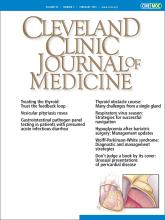Article Figures & Data
Tables
- TABLE 1
Medications for managing post–bariatric surgery hypoglycemia: Mechanisms of action
Medication Mechanism of action Acarbose8,23,25,26 Inhibits intestinal alpha-glucosidase—delays absorption of glucose from the intestine, decreases postprandial glycemic and insulinemic peaks Diazoxide26–28 Reduces insulin secretion by inhibition of beta-cell adenosine triphosphate–sensitive potassium channels, induces hepatic gluconeogenesis Octreotide, pasireotide25,26,29 Somatostatin analogs delay gastric emptying, reduce insulin and GLP-1 secretion Nifedipine or verapamil25,30 Inhibits insulin release by inhibiting calcium channels in pancreatic beta cells GLP-1 analogs25,26,31 Decreases variability in GLP release, which causes synchronous insulin and glucose peaks, delays gastric emptying, decreases appetite, stimulates glucagon secretion Dipeptidyl peptidase 4 inhibitors25,26 Reduces the degradation of GLP-1 and glucose-dependent insulinotropic polypeptide and raises their levels GLP-1 antagonist32–34 Prevents surges in GLP-1 and insulin, increases glucagon secretion SGLT-2 inhibitors35,36 Reduces carbohydrate absorption by inhibiting intestinal SGLT-1 and increasing hepatic glucose production Interleukin 1 beta antagonist (anakinra)37 Decreases dysregulated proinflammatory signaling, which can cause excessive insulin response Glucagon38,39 Glucagon receptor agonist, stimulates glycogenolysis and hepatic gluconeogenesis Insulin receptor antibody (XOMA 358)40,41 Reverses insulin-induced hypoglycemia by significantly decreasing insulin sensitivity and increasing hepatic glucose output GLP = glucagon-like peptide; SGLT = sodium-glucose cotransporter
- TABLE 2
Medications for managing post–bariatric surgery hypoglycemia: Dosages and side effects
Medication Dosage Side effects Notes Acarbose8,23,25,26 25 mg with 1 meal per day, slowly titrate up to 100 mg at every meal daily Bloating, abdominal cramping, diarrhea Used as first line because it’s affordable and available
Not recommended in significant renal impairment
If hypoglycemia occurs, correct with simple carbohydrates (glucose, dextrose, honey)—complex carbohydrates (table sugar, juice, soft drink, candy) will not be effectiveDiazoxide26–28 50–100 mg twice daily to start Fluid retention, edema, nausea, hypotension, hirsutism, headache Consider dose reduction with renal impairment
Typically used for hypoglycemia from insulinomas
Affordability and insurance coverage are barriersOctreotide, pasireotide25,26,29 Octreotide 25–100 μg SC before meals
Octreotide long-acting repeatable 20-mg intramuscular injection monthly
Pasireotide 50–300 μg
SC before meals or 300 μg
SC dailyDiarrhea, steatorrhea, cholelithiasis, hyperglycemia (more with pasireotide), QT prolongation Safe to use in renal impairment
Expensive
Screening abdominal ultrasonography and electrocardiogram required
Pasireotide is longer acting than octreotide and is available for compassionate use in severe PBH
Oral octreotide is available but has not been used for this indicationNifedipine or verapamil25,30 Verapamil 40 mg 3 times daily
Nifedipine 30–60 mg dailyHypotension, edema Safe to use in renal impairment GLP-1 analogs25,26,31 Liraglutide 0.6 mg titrated to 1.2 mg SC daily, up to 1.8 mg daily Nausea, constipation Contraindicated in patients with family or personal history of medullary thyroid carcinoma
Use with caution in patients with history of pancreatitis
Safe to use in renal impairment but avoid dehydration
ExpensiveDipeptidyl peptidase 4 inhibitors25,26 Sitagliptin 100 mg once daily Nausea, constipation Inconclusive results—not recommended GLP-1 antagonist32–34 Avexitide 30 mg SC twice daily Headache, nausea, injection-site reaction Recently granted breakthrough therapy designation by the US
Food and Drug Administration for treating PBH and congenital hyperinsulinism, currently in phase 3 trialSGLT-2 inhibitors35,36 Canagliflozin 100 or 300 mg daily
Empagliflozin 10–25 mg dailyDehydration, urinary tract and genital mycotic infections, euglycemic diabetic ketoacidosis Dosage adjustment required in renal impairment
Canagliflozin and empagliflozin shown to improve glycemic response to oral glucose tolerance and mixed meal tolerance tests, respectively, in patients with PBHInterleukin 1 beta antagonist37 Anakinra 100 mg SC daily Anakinra and SGLT-2 inhibitor empagliflozin reduced the number of hypoglycemic events during a liquid mixed meal test Glucagon38,39 Dasiglucagon 80 or 120 μg
SC injection as needed for hypoglycemiaNausea, vomiting, hyperglycemia, reduced appetite Still under clinical investigation, use of glucagon in an insulin pump has shown satisfactory results
May be used for treatment of acute severe hypoglycemiaInsulin receptor antibody40,41 XOMA 358
3–9 mg/kg dailyHeadache, hyperhidrosis Results from phase 2 trial not announced yet GLP = glucagon-like peptide; SC = subcutaneous; PBH = post–bariatric surgery hypoglycemia; SGLT = sodium-glucose cotransporter






